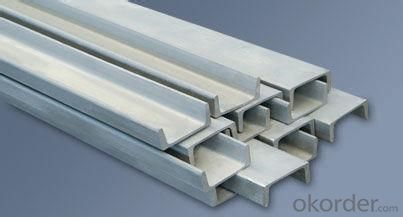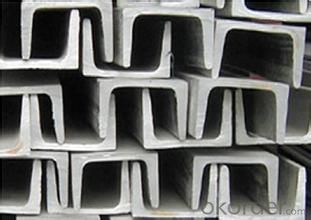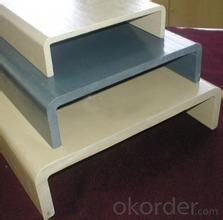GB U Channel Steel
- Loading Port:
- China Main Port
- Payment Terms:
- TT or LC
- Min Order Qty:
- -
- Supply Capability:
- -
OKorder Service Pledge
OKorder Financial Service
You Might Also Like
Product Description:
OKorder is offering GB U Channel Steel at great prices with worldwide shipping. Our supplier is a world-class manufacturer of steel, with our products utilized the world over. OKorder annually supplies products to European, North American and Asian markets. We provide quotations within 24 hours of receiving an inquiry and guarantee competitive prices.
Product Applications:
GB U Channel Steel are ideal for structural applications and are widely used in the construction of buildings and bridges, and the manufacturing, petrochemical, and transportation industries.
Product Advantages:
OKorder's GB U Channel Steel are durable, strong, and resist corrosion.
Main Product Features:
· Premium quality
· Prompt delivery & seaworthy packing (30 days after receiving deposit)
· Corrosion resistance
· Can be recycled and reused
· Mill test certification
· Professional Service
· Competitive pricing
Product Specifications:
Manufacture: Hot rolled
Grade: Q195 – 235
Certificates: ISO, SGS, BV, CIQ
Length: 6m – 12m, as per customer request
Packaging: Export packing, nude packing, bundled
Chinese Standard (H*W*T) | Weight (Kg/m) | 6m (pcs/ton) | Light I (H*W*T) | Weight (Kg/m) | 6m (pcs/ton) | Light II (H*W*T) | Weight (Kg/m) | 6M |
100*68*4.5 | 11.261 | 14.8 | 100*66*4.3 | 10.13 | 16.4 | 100*64*4 | 8.45 | 19.7 |
120*74*5.0 | 13.987 | 11.9 | 120*72*4.8 | 12.59 | 13.2 | 120*70*4.5 | 10.49 | 15.8 |
140*80*5.5 | 16.89 | 9.8 | 140*78*5.3 | 15.2 | 10.9 | 140*76*5 | 12.67 | 13.1 |
160*88*6 | 20.513 | 8.1 | 160*86*5.8 | 18.46 | 9 | 160*84*5.5 | 15.38 | 10.8 |
180*94*6.5 | 24.143 | 6.9 | 180*92*6.3 | 21.73 | 7.6 | 180*90*6 | 18.11 | 9.2 |
200*100*7 | 27.929 | 5.9 | 200*98*6.8 | 25.14 | 6.6 | 200*96*6.5 | 20.95 | 7.9 |
220*110*7.5 | 33.07 | 5 | 220*108*7.3 | 29.76 | 5.6 | 220*106*7 | 24.8 | 6.7 |
250*116*8 | 38.105 | 4.3 | 250*114*7.8 | 34.29 | 4.8 | 250*112*7.5 | 28.58 | 5.8 |
280*122*8.5 | 43.492 | 3.8 | 280*120*8.2 | 39.14 | 4.2 | 280*120*8 | 36.97 | 4.5 |
300*126*9 | 48.084 | 3.4 | 300*124*9.2 | 43.28 | 3.8 | 300*124*8.5 | 40.87 | 4 |
320*130*9.5 | 52.717 | 3.1 | 320*127*9.2 | 48.5 | 3.4 | |||
360*136*10 | 60.037 | 2.7 | 360*132*9.5 | 55.23 | 3 |
FAQ:
Q1: Why buy Materials & Equipment from OKorder.com?
A1: All products offered byOKorder.com are carefully selected from China's most reliable manufacturing enterprises. Through its ISO certifications, OKorder.com adheres to the highest standards and a commitment to supply chain safety and customer satisfaction.
Q2: How do we guarantee the quality of our products?
A2: We have established an advanced quality management system which conducts strict quality tests at every step, from raw materials to the final product. At the same time, we provide extensive follow-up service assurances as required.
Q3: How soon can we receive the product after purchase?
A3: Within three days of placing an order, we will begin production. The specific shipping date is dependent upon international and government factors, but is typically 7 to 10 workdays.
Q4: What makes stainless steel stainless?
A4: Stainless steel must contain at least 10.5 % chromium. It is this element that reacts with the oxygen in the air to form a complex chrome-oxide surface layer that is invisible but strong enough to prevent further oxygen from "staining" (rusting) the surface. Higher levels of chromium and the addition of other alloying elements such as nickel and molybdenum enhance this surface layer and improve the corrosion resistance of the stainless material.
Q5: Can stainless steel rust?
A5: Stainless does not "rust" as you think of regular steel rusting with a red oxide on the surface that flakes off. If you see red rust it is probably due to some iron particles that have contaminated the surface of the stainless steel and it is these iron particles that are rusting. Look at the source of the rusting and see if you can remove it from the surface.
Images:



- Q:What are the common steel finishes for I-beams?
- There are several common steel finishes for I-beams, each serving a specific purpose and offering unique benefits. The most common finishes include: 1. Mill finish: This is the basic finish that steel beams have when they come directly from the mill. It is a raw, untreated surface with a dark gray color. Mill finish is often preferred for its cost-effectiveness and versatility, as it can be easily painted or coated for additional protection against corrosion. 2. Hot-dip galvanized: This finish involves immersing the I-beams in a bath of molten zinc, creating a protective coating on the steel surface. Hot-dip galvanizing provides excellent corrosion resistance, making it ideal for outdoor applications where the beams are exposed to moisture, humidity, and harsh weather conditions. 3. Primed: Priming involves applying a layer of primer paint to the surface of the steel beams. This finish provides a protective barrier against corrosion and prepares the surface for additional coats of paint. Primed I-beams are commonly used in construction projects where the desired color and appearance are important. 4. Powder coated: Powder coating is a process that involves applying a dry powder paint to the surface of the steel beams. The beams are then heated, causing the powder to melt and form a durable, smooth finish. Powder coating offers excellent resistance to chipping, scratching, and fading, making it suitable for both indoor and outdoor applications. 5. Stainless steel finish: I-beams made from stainless steel have a natural, glossy finish that is highly resistant to corrosion and staining. Stainless steel beams are commonly used in environments where hygiene, cleanliness, and resistance to chemical exposure are crucial, such as food processing plants, hospitals, and laboratories. These are some of the most common steel finishes for I-beams, and the choice of finish depends on factors such as the intended application, environmental conditions, aesthetics, and budget. It is essential to select the appropriate finish to ensure the longevity and performance of the I-beams in their specific usage scenario.
- Q:Can steel I-beams be used in outdoor applications?
- Yes, steel I-beams can be used in outdoor applications. Steel I-beams are known for their strength and durability, making them suitable for various construction projects, including outdoor applications. They are commonly used in outdoor structures such as bridges, building frames, and support structures. Steel is resistant to weather elements such as rain, wind, and extreme temperatures, making it ideal for outdoor use. Additionally, steel can be treated or coated to provide further protection against corrosion and rust, ensuring its longevity in outdoor environments. Overall, steel I-beams are a reliable and versatile choice for outdoor applications due to their strength, durability, and resistance to weather conditions.
- Q:Can steel I-beams be painted or coated to match the desired aesthetics?
- Yes, steel I-beams can be painted or coated to match the desired aesthetics. Painting or coating the I-beams can provide a finished appearance, enhance their durability, and protect them from corrosion. This allows for customization and integration of the I-beams into various architectural designs and color schemes.
- Q:Are there any limitations to the length of steel I-beams?
- The length of steel I-beams is subject to certain limitations. These limitations arise from factors such as manufacturing capabilities, transportation logistics, and structural considerations. Manufacturing capabilities are a significant factor in determining the size and length of steel I-beams that can be produced. Steel mills and fabrication facilities have specific equipment and processes that may impose restrictions on the maximum length that can be efficiently and cost-effectively manufactured. Transportation logistics also play a vital role in limiting the length of steel I-beams. The size and weight of longer beams can pose challenges during transportation from the manufacturing facility to the construction site. Road and bridge weight restrictions, transportation infrastructure limitations, and the availability of specialized equipment for handling and transporting long beams can further restrict their length. Structural considerations are another important limitation. Longer steel I-beams have a higher risk of deflection or bending under load. Beyond a certain length, the structural integrity of the beam may be compromised, posing potential safety concerns. Structural engineers and architects must carefully analyze the load-bearing requirements of a project and determine the maximum allowable length for steel I-beams based on factors such as load distribution, beam design, and support systems. In conclusion, while steel I-beams can be manufactured in various lengths, there are limitations imposed by manufacturing capabilities, transportation logistics, and structural considerations. It is crucial to collaborate with industry professionals to ensure that the length of steel I-beams used in construction projects adheres to these limitations while meeting the necessary design standards and safety regulations.
- Q:What are the considerations for thermal insulation when using steel I-beams?
- When using steel I-beams for thermal insulation, there are several considerations to keep in mind. Firstly, the type and thickness of insulation material should be carefully selected to ensure optimal thermal performance. It is important to choose materials with high R-values, which indicate their ability to resist heat transfer. Additionally, proper installation techniques should be followed to avoid any gaps or air leaks that could compromise the insulation's effectiveness. Furthermore, the insulation system should be designed to prevent condensation and moisture buildup, as this can lead to corrosion and reduced structural integrity of the steel beams. Lastly, any fire safety regulations or requirements for the specific application should be taken into account to ensure that the insulation material used meets the necessary fire resistance ratings. Overall, considering these factors will help to achieve efficient thermal insulation while maintaining the structural integrity of the steel I-beams.
- Q:Can steel I-beams be used in both residential and commercial buildings?
- Yes, steel I-beams can be used in both residential and commercial buildings. They are commonly used in construction for their strength and durability, making them suitable for a wide range of building types and sizes.
- Q:What is the material of hot rolled ordinary I-beam?
- I-beam is also called steel girder (English name Universal Beam). It is a strip of steel with an I-shaped section. I-beam is made of ordinary I-beam and light i-beam. It is a section steel with an I-shaped section.
- Q:Can steel I-beams be custom fabricated?
- Certainly! Steel I-beams can indeed be custom fabricated. Custom fabrication of steel I-beams pertains to the manufacturing procedure of these structural components in accordance with precise design requisites, encompassing distinct measurements, lengths, and load-bearing capacities. This grants the opportunity for tailor-made solutions to address the specific requirements of diverse construction undertakings. The process of custom fabrication of steel I-beams entails cutting, welding, and molding the steel in order to attain the desired specifications. This task is typically executed by seasoned steel fabricators who possess the expertise, aptitude, and apparatus to undertake such ventures. The capability to custom fabricate steel I-beams is of utmost importance in numerous industries, including construction, engineering, and architecture, as it facilitates the establishment of structures that are both secure and efficient.
- Q:What is the lifespan of a painted steel I-beam?
- The lifespan of a painted steel I-beam can vary depending on various factors such as the quality of the paint, environmental conditions, and maintenance. However, with proper coating and maintenance, a painted steel I-beam can typically last for several decades or even longer.
- Q:Span 6 meters, 5 meters deep into the terrace, with steel frames from 4CM thick wood, used as light warehouse, I do not know what kind of I-beam, how layout?
- With 10# I-beam, gb. Tile along the deep direction, the distance between 40-60 cm (see the strength of the wood you use, if it is a good board, relatively strong, that can take 60 cm), and then screw the wood and I-beam links.
1. Manufacturer Overview |
|
|---|---|
| Location | |
| Year Established | |
| Annual Output Value | |
| Main Markets | |
| Company Certifications | |
2. Manufacturer Certificates |
|
|---|---|
| a) Certification Name | |
| Range | |
| Reference | |
| Validity Period | |
3. Manufacturer Capability |
|
|---|---|
| a)Trade Capacity | |
| Nearest Port | |
| Export Percentage | |
| No.of Employees in Trade Department | |
| Language Spoken: | |
| b)Factory Information | |
| Factory Size: | |
| No. of Production Lines | |
| Contract Manufacturing | |
| Product Price Range | |
Send your message to us
GB U Channel Steel
- Loading Port:
- China Main Port
- Payment Terms:
- TT or LC
- Min Order Qty:
- -
- Supply Capability:
- -
OKorder Service Pledge
OKorder Financial Service
Similar products
New products
Hot products
Related keywords





























